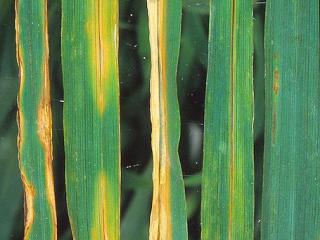Bacterial blight and Septoria avenae blotch are appearing in oats
Bacterial blight
- Muresk
Plant pathologist Kylie Chambers (DPIRD) has reported finding low levels of bacterial blight on several oat varieties in an oat trial at Muresk.
There are two bacterial blights that can affect oats in Western Australia, stripe blight (Pseudomonas syringae pv. striafaciens) and halo blight (Pseudomonas syringae pv. coronafaciens).
Stripe blight, the most common form in WA, forms long, red-brown stripes on leaves during winter, which join into blotches that can cause leaf collapse.
Halo blight causes buff-coloured, oval-shaped spots surrounded by a pale halo with a water-soaked appearance.
These bacteria need moist conditions with cool showery weather to spread and will stop spreading as canopies dry. Normally crops outgrow the infection in spring. The recent period of mild wet conditions will have been favourable for expression and spread of stripe blight.
Spread of bacterial blight within oat crops is mainly by water movement such as rain splash or in some cases vehicle movement through a wet crop. The bacteria survive in crop stubble and soil debris for up to two years and can also be seed borne. Seed borne infection often results in hotspots of infection within paddocks.
Currently there are no crop protection chemicals suitable to control this disease.
The important point is that bacterial blight should not be confused with fungal diseases like septoria avenae or oat rust. These fungal diseases can be suppressed by use of fungicides whereas the bacterial blight is unaffected.
For more information see DPIRD’s Diagnosing stripe blight in oats and Diagnosing halo blight in oats pages.
Septoria avenae blotch
- Dale
Plant pathologist Kylie Chambers (DPIRD) has also reported finding low levels of Septoria avenae blotch on several oat varieties in an oat trial at Dale.
Septoria avenae blotch symptoms can appear as brown to purple spots on leaves developing into light and dark brown blotches, with dark brown centres. They are restricted and distinct at first but may enlarge to cover most of the leaf.
Infected stubble is the main source of carryover infection from one season to another. The sexual stage of the fungus Phaeosphaeria avenaria occurs on infected stubble and produces ascospores which are spread moderate distances by wind and are the source of infection in new crops. In consecutive oat rotations where stubble is not destroyed ascospores land on the new crop in large quantities resulting in the development of earlier and more severe outbreaks than in rotation crops.
Septoria avenae blotch can be minimised by avoiding continuous oat cropping but under high disease pressure, such as continuous oat crops, and in favourable environments foliar fungicides can be utilised to reduce disease severity and reduce potential disease losses.
Trials carried out in 2014 by Ashton Gray (formerly ConsultAg) showed that application of registered fungicide as a single spray at flag leaf or multiple sprays at stem extension and again at flag leaf could result in significant yield increase in the susceptible variety Bannister sown onto oat stubble. For further reading refer to the Best practice fungicide management for Bannister oats in the medium and high rainfall zones of Western Australia Crop Updates paper.
For a list of registered fungicides to use as foliar sprays visit DPIRD’s Registered foliar fungicides for cereals in Western Australia page.
For more information visit DPIRD’s Diagnosing septoria avenae blotch in oats and Oats: leaf diseases pages.
For more information on oat foliar diseases contact Plant pathologists Geoff Thomas, South Perth on +61 (0)8 9368 3262 or Kylie Chambers, Northam on +61 (0)8 9690 2151.
Article author: Cindy Webster (DPIRD Narrogin).



